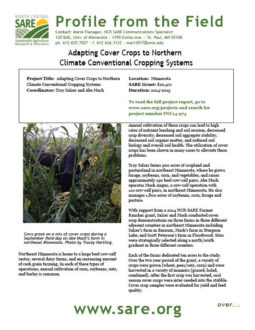Northeast Minnesota is home to a large beef cow-calf sector, several dairy farms, and an increasing amount of cash grain farming. In each of these types of operations, annual cultivation of corn, soybeans, oats, and barley is common.
Annual cultivation of these crops can lead to high rates of nutrient leaching and soil erosion, decreased crop diversity, decreased soil aggregate stability, decreased soil organic matter, and reduced soil biology and overall soil health. The utilization of cover crops has been shown in many cases to alleviate these problems.
Troy Salzer farms 900 acres of cropland and pastureland in northeast Minnesota, where he grows forage, soybeans, corn, and vegetables, and raises approximately 190 beef cow-calf pairs. Abe Mach operates Mach Angus, a cow-calf operation with 110 cow-calf pairs, in northeast Minnesota. He also manages 1,800 acres of soybeans, corn, forage and pasture.
With support from a 2014 NCR-SARE Farmer Rancher grant, Salzer and Mach conducted cover crop demonstrations on three farms in three different adjacent counties in northeast Minnesota including Salzer’s farm in Barnum, Mach’s farm in Sturgeon Lake, and Scott Peterson’s farm in Floodwood. Sites were strategically selected along a north/south gradient in three different counties.
Each of the farms dedicated ten acres to the study. Over the two year period of the grant, a variety of crops were grown (wheat, peas/oats, corn) and were harvested in a variety of manners (grazed, baled, combined). After the first crop was harvested, cool season cover crops were inter-seeded into the stubble. Cover crop samples were evaluated for yield and feed quality.
Over the period of the two year study, they determined that cover crops could extend the growing season in northeast Minnesota while maintaining soil cover and providing opportunities to improve soil health for cropping systems. They also concluded that cover crops (specifically winter rye and turnips) could produce the quality of feed necessary to adequately finish beef with grass/forage due to the levels of crude protein and digestible dry matter.
“Winter Rye and turnip emergence was very good,” said Mach. “Lack of vigorous growth suggests fertility issues. I go back in my mind to the common thread through all of this research: fertility, fertility, fertility! We can’t build soil health and composition in a timely fashion without the nutrients! If we import the nutrients at the beginning and in a form that won’t leach and is available, we can capitalize on recycling these nutrients through forage growth, and subsequent livestock utilization and trampling impact.”
As part of their project, they developed a list of suggested management techniques to improve the success of implementing cover crops including; selecting cold tolerant cover crop seeds, planting as early as possible, addressing soil fertility issues, selecting fields conducive to productive grazing, and utilizing high quality forage.
View Troy and Abe's presentation on this project, from the 2016 Farmers Forum, through NCR-SARE's YouTube playlist. Visit www.youtube.com/NCRSAREvideo for this and other videos.
